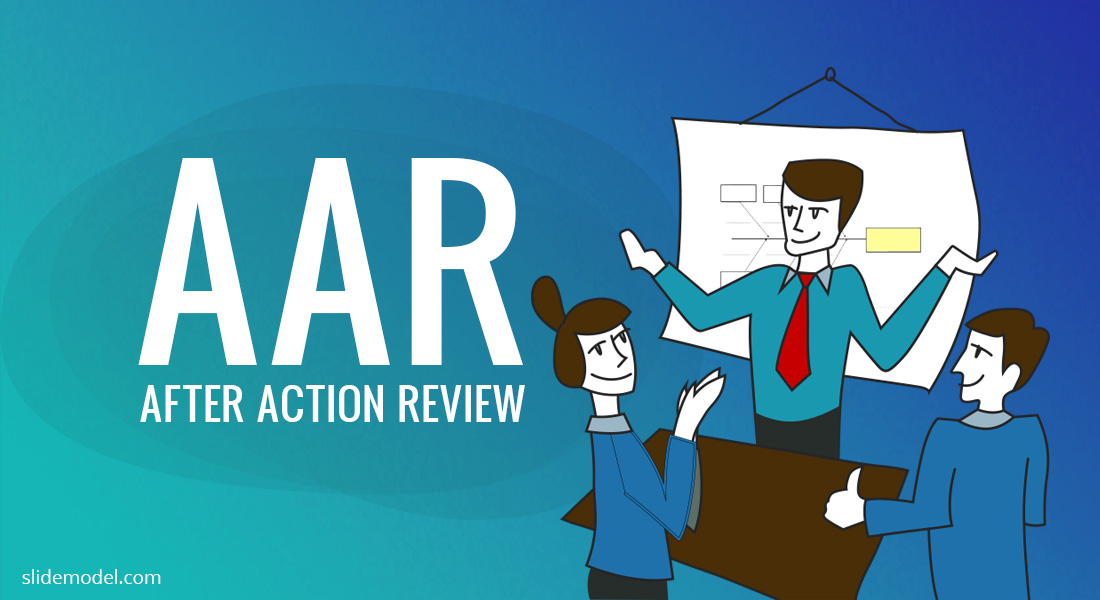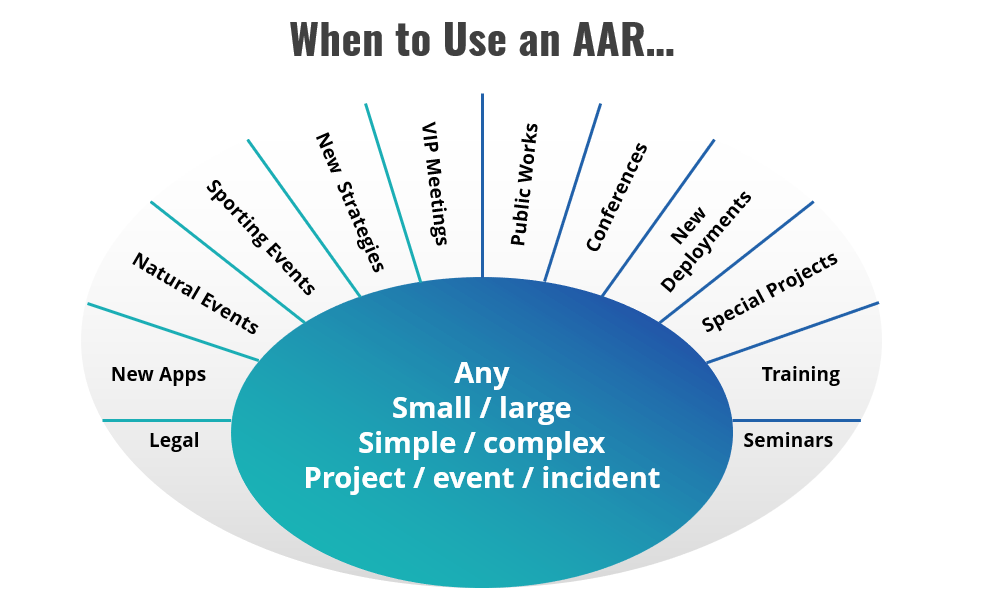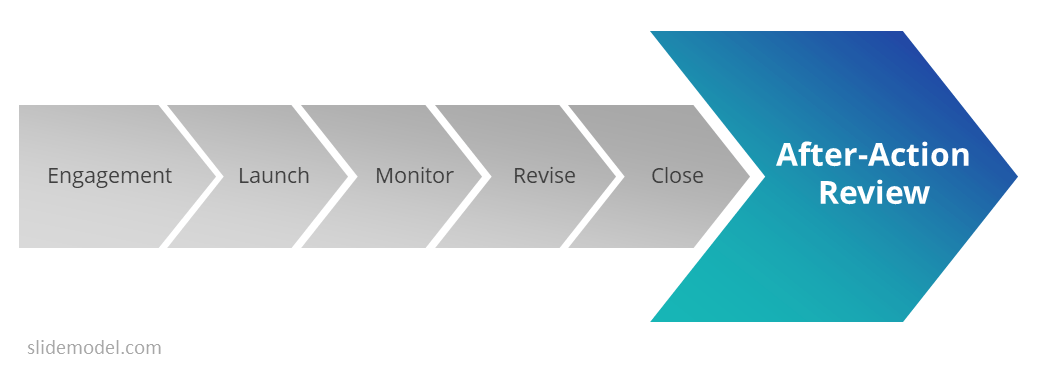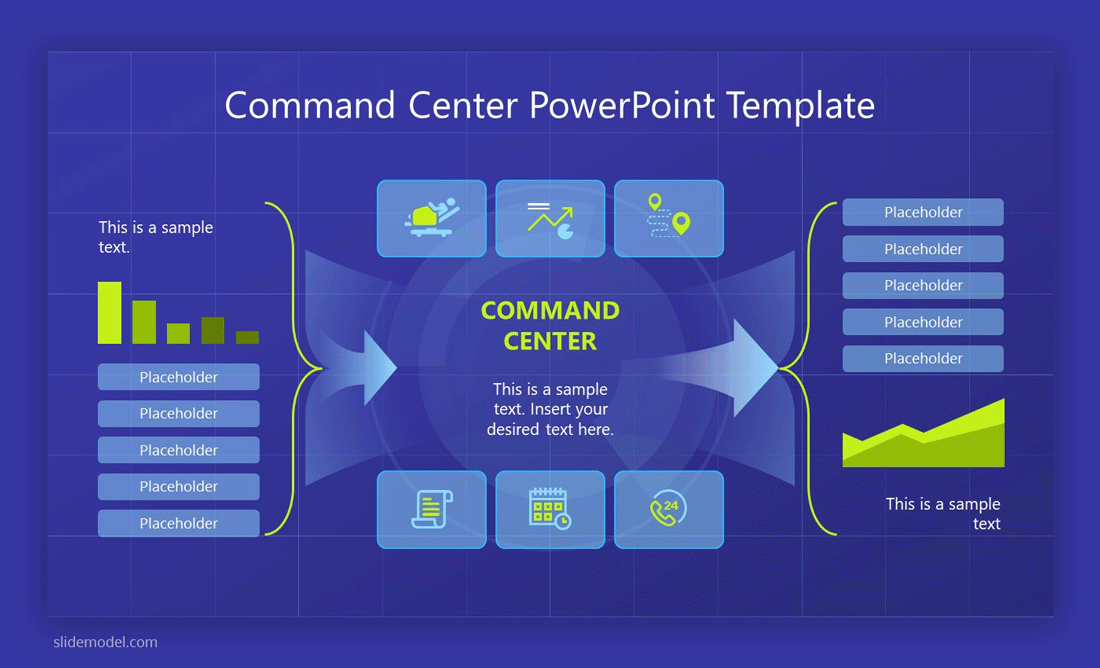Which of the Following Is One of the Four Steps in the Execution Sequence of an After Action Review

Business mistakes are costly – virtually leaders know that. But few take proactive steps to investigate the root cause and found corrective measures while the project is withal on track. Indeed, most investigations are often done post mortem – when the deed is done, and naught can be inverse per se.
But that's non the only manner of how a manager can evaluate the success of their endeavors. In fact, the near constructive companies don't await until the wrap up to start learning about possible mishaps. Instead, they practice continuous evaluation throughout the projection lifecycle. In a nutshell, that'south what is AAR (After Activity Review) entails.
What is an After Activeness Study?
At its simplest, an afterwards-action report is a detailed description of an action or event that has occurred with an assay of what went right, what went wrong and so looking at how that action can be improved for the future. This afterward-activeness review is then reduced to writing, in an later on-activeness report, then that it is bachelor for future reference.
The AAR process was commencement designed by the U.S. military, in its training exercises, simulating war zone situations and events. After each do, there was a review to assess successes, failures, and flaws in both strategies and implementations. Afterwards, the team compiled a formal military after action written report that concluded and recorded all the findings for futurity reference.
In the tardily 90s, the AAR exercise fabricated its style to the manufacture. Beat Oil Visitor was among the first to add this model to their project management toolkit. Earlier this, the common practice at Vanquish and, indeed, withal in use by many organizations, was a post-mortem analysis.
Projection Post Mortem vs. Later Activeness Review: Key Differences
Both practices are aimed at analyzing the aftermath of certain actions and making respective conclusions. Even so, they pursue somewhat different purposes.
The goal of conducting a project management mail service mortem is to dissect by events to explain what happened and why. The purpose of AAR, on the other hand, is to help the team prepare for a hereafter challenge through analyzing the past.
Some other of import deviation is that postal service mortems are typically planned after the project/event. Later action reviews are planned before a project/consequence from the perspective that learning should take identify during the project. The afterward activity review format too assumes scheduling multiple meetings, not merely ane.
| Typical Post-Mortem | Typical AAR Do |
|---|---|
| Purpose: to dissect past events to document and explain what happened | Purpose: to ready for a tangible claiming in the near hereafter |
| Planned later on the project or event, from the perspective that agreement and insight is clearest in hindsight. Meeting is held before long after project completion. | Planned before the project or event from the perspective that learning and improvement must happen throughout the projection. Multiple meetings throughout the project. |
| Takes place as a coming together of all involved, followed past a presentation to others such every bit executives. | Takes place in small, task-focused groups, followed by activeness by those same people. |
| Reviews the entire process, aiming to be thorough | Reviews moments, issues, or measures seen as relevant to going frontward |
| Produces a detailed report containing analysis and recommendations for others. | Produces an action program that participants generated and will implement themselves. |
Source: The Systems Thinker
Benefits of an After-Activity Review
A project mail service-mortem assay is certainly valuable, and information technology may inform decisions most the next related project. But what if that failed project could have been more successful if only there had been some reviews along the way, at the end of each step or phase, that would have impacted the end upshot?
This is the whole bespeak of afterwards-action reviews and reports – to learn all forth the way, to make the necessary changes needed in-process, and to improve the chances of a project'due south success.
Consider the benefits that any organization, across all sectors, tin can achieve through after-action reviews.
- An after action review gives the players the adventure to evaluate what happened and why information technology happened. These types of discussions focus on learning (equally opposed to who did what and potential blame). This totally differs from the mail-mortem review that occurs after a project has failed and is declared expressionless. These types of reviews tend to focus on "accountability", and go out team participants discouraged and sometimes guilty.
- Problems can exist discovered early on in the process and modifications made at that indicate. If, for example, a company has changed its supply chain direction process, an AAR can occur after the very first run of a prepare number of supplied products, identifying snags, and fixing them before whatsoever more than runs occur.
- AAR tin be used for more than than just projects. Companies often plan grooming programs for their staff and/or teams. Conducting an AAR post-obit the first session tin be beneficial for assessing the effectiveness and making decisions regarding modifying future sessions. And when a safety event occurs in a manufacturing constitute, an AAR can upshot in lessons learned for future prevention.
- Regular AAR will better relationships and communication amidst team members, particularly considering the focus is on learning from an activity or activity. Team members recollect more about how to work together to improve results.
When to Employ After Action Reviews

Source: Based on The importance of Activeness-Activeness Reports by Steve Finney, Jr.
Almost any activity that is conducted by a business organization organization can benefit from this procedure. Hither are some additional instances in which AAR'southward should be utilized.
- New IT integrations: When a business organization is adding new software solutions, information technology makes sense to join the stakeholders during phases of integration, in gild to assess what is working and what glitches users are experiencing.
- New business organisation strategies. Whether in marketing, human resources, operations, logistics, etc., whatever new strategy implementation volition have issues. Rather than wait until the full coil-out, cess along the way, every bit each phase is put into place.
- Special projects. Most projects are designed and completed in phases. Holding AAR discussions after each stage of development will prevent the need for project management post mortem when that project is unsuccessful.
- Departmental reorganizations. This can exist a stressful time for everyone involved. Equally each stage is implemented, an AAR can bring those stressors into focus, identify the causes, and mitigate them every bit additional phases occur.
It is important to recollect most the risks of non conducting AAR analyses in these circumstances. The biggest run a risk, of course, is that mistakes, issues, or flaws go uncorrected, business organisation goals/objectives are not met, and/or projects fail. The retrospective process of assessment after a failure has occurred wastes both time and money.
How to Write an After Activity Report
The standard After Action Review format assumes the following key steps:
- Plan the operation and fix objectives.
- Launch the functioning (due east.one thousand. beginning training session, initial run of a new product, etc.)
- Monitor what is going on, because some bug can and should be caught and "fixed" in-procedure (eastward.g., a machine malfunction).
- Close the operation/task.
- Conduct the after-action review.
- Prepare an after-activeness report based upon the review.
Hither is a visual of an Afterwards Action Review template that you can use for quick reference:

The Key After Action Review Questions To Respond
4 questions must be answered during the after action review.
- What were the intended results? (goals/objectives of the action)
- What were the actual results? (goals/objectives met or not met)
- What caused the results that we got?
- What actions will we proceed, what should be revised/improved, and what should be "dumped" (this is the learning that volition drive what happens going forward)
The answers to these questions will be the "meat" of the afterwards-action review report or presentation that will follow. Remember, the goal of this practice is to learn not to place blame. I of the things the Army says as the review process begins is, "Go out your rank at the door," and this should be the mantra of all participants in the review process.
The Guiding Principle for Creating an ARR Report and Presentation
After-action review reports can be informal or formal, depending upon the audience for that report. Inside a small team, for example, that report may exist as unproblematic equally preparing a flip-nautical chart of the results and the changes that will exist fabricated going forward. These can then be reduced to writing so that all team members have the changes that are to be implemented.
In other instances, however, a larger audience is involved, and a more formal report or presentation is appropriate. The ideal option is to use a business after activity report template that will provide a visual depiction of the process and deed as a facilitator during the word role. Below are several principles that should help yous create a reusable after action report sample for your organization's needs.
Rely on 4 Master After Action Review Steps
To conduct a successful AAR review session, make certain that the word follows the side by side five steps:
Step one: Establish the intent. Every report should first clarify the objective. Yous'll want to specify what are the intended results and metrics for the 'action' in question; why we are trying to accomplish them now and what results do nosotros conceptualize to become.
Footstep two: Outline the performance. Mention the potential challenges that may ascend during the execution; summarize what has been accomplished then far and provide a breakdown of the results achieved. Here a basic "input-output" template can come handy to make a presentation visually clear to an audience:

The input in the afterward-action study template will obviously be the objectives of the action, the program for implementation of the action, and the details of the launch of the action. The central portion will be the activities that occurred during implementation.
The output section volition be the results of the action/chore in meeting the original objectives and the review that took identify (including what should be revised or modified for the side by side phase).
Footstep 3: Report on the learnings. At this part of your report focus on laying out the knowledge obtained by your team (or others) earlier execution, during the project and post-commitment. Your goal here not to focus on failure or arraign, but rather provide a holistic view on:
- What were the obstacles that prevented progress?
- What were the systemic strengths and weaknesses?
- How did these compare to the risks your organization has anticipated before execution?
Step 4: Provide a future outlook. Conspicuously communicate what types of adjustments y'all should make adjacent fourth dimension i.e. establish the cosmetic measures and a new execution sequence of an later on activeness review.
Following the proposed 4-step approach volition allow y'all to create a comprehensive and detailed AAR report, likewise as a presentation (if needed), that could be later on referred to past others in your organisation. After all, improvements come as a event of innovatively-driven alter based on private feedback, reflection and learning. Later on action reviews allow to achieve simply that.
Conclusions
Ultimately, after-activity reviews provide managers with a truly effective approach to identifying valuable insights from past experiences. And the guiding principle of such reviews is that learning tin exist a continuous process equally tasks and projects are launched and implemented in phases, and each phase is subjected to a review before going forward. When this model is adopted, equally opposed to a final review after a full projection is completed, the chances of coming together business goals and objectives are vastly improved.

Source: https://slidemodel.com/after-action-review-managerial-guide-to-aar/
Post a Comment for "Which of the Following Is One of the Four Steps in the Execution Sequence of an After Action Review"